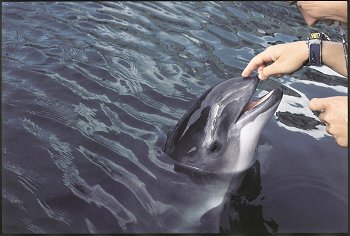|
| Query: Pacific herring | Result: 33rd of 36 | |
Harbour Porpoise (Phocoena phocoena) - Wiki
| Subject: | Harbour Porpoise (Phocoena phocoena) - Wiki
| |

| Resolution: 350x236
File Size: 24682 Bytes
Upload Date: 2007:08:13 00:38:40
|
Harbour Porpoise
From Wikipedia, the free encyclopedia
[Photo] A Harbour Porpoise. Photo from the Danish Wikipedia, http://da.wikipedia.org/wiki/Billede:Marsvin.jpg
The Harbour Porpoise (Phocoena phocoena) is one of six species of porpoise. It is one of the smallest ocean mammals in the sea. As its name implies, it stays close to coastal areas or river estuaries and as such is the most familiar porpoise to whale watchers. This porpoise often ventures up rivers and has been seen hundreds of miles from the sea.
The species is sometimes known as the Common Porpoise in texts originating in the United Kingdom, though this usage appears to be dying out.
Physical description
The Harbour Porpoise is a little smaller than the other porpoises. It is about 67-85 cm (26-33 in) long at birth. Both sexes grow up to be 1.4 m to 1.9 m (4.6-6.2 ft). The females are correspondingly heavier, with a maximum weight of around 76 kg (167 pounds) compared with the males' 61 kg (134 pounds). The body is robust and the animal is at its maximum girth just in front of its triangular dorsal fin. The beak is poorly demarcated. The flippers, dorsal fin, tail fin and back are a dark grey. The sides are a slightly speckled lighter grey. The underside is much whiter, though there are usually grey stripes running along the throat from the underside of the mouth to the flippers. Harbour Porpoises can live up to 25 years.
Population and distribution
The species is widespread in cooler coastal waters in the Northern Hemisphere, largely in areas with a mean temperature of about 15°C. In the Atlantic, Harbour Porpoises may be present in a concave band of water running from the coast of western Africa round to the eastern seaboard of the United States, including the coasts of Spain, France, the United Kingdom, Ireland, Norway, Iceland, Greenland and Newfoundland. In prehistoric times this animal was hunted by the Alby People of the east coast of Oland, Sweden. There is a similarly-shaped band in the Pacific Ocean running from Sea of Japan, Vladivostok, the Bering Strait, Alaska and down to Seattle and Vancouver. There are diminishing populations in the Black and Baltic Seas.
Prey and predators
Harbour Porpoises feed mostly on small fish, particularly herring, capelin, and sprat. The deepest dive recorded was 224 m (735 ft) deep. Young porpoises need to consume about 7% to 8% of their body weight each day in order to survive.
Significant predators of Harbour Porpoises include white sharks and Orcas. Researchers at the University of Aberdeen in Scotland have also discovered that the local Bottlenose Dolphins attack and kill Harbour Porpoises without eating them due to competition for a decreasing food supply.
Conservation
Harbour Porpoises are not and never have been actively hunted by whalers because they are too small to be of interest. The global population is in the hundreds of thousands and the Harbour Porpoise is not under threat of widespread extinction. However a key concern is the large number of porpoises caught each year in gill nets and other fishery equipment. This problem has led to a documented decrease in the number of Harbour Porpoises in busy fishing seas such as the Black and Baltic. It is known that the porpoises' echolocation is sufficiently discriminating to detect the presence of the nets, but this does not stop porpoises from becoming trapped. Scientists have developed beacons to attach to the nets to try to deter curious porpoises. These are not yet widespread and there is some controversy regarding their use???some concerns have been raised about the value of adding more noise pollution to the seas.
http://en.wikipedia.org/wiki/Harbour_Porpoise
| The text in this page is based on the copyrighted Wikipedia article shown in above URL. It is used under the GNU Free Documentation License. You may redistribute it, verbatim or modified, providing that you comply with the terms of the GFDL. |
|
Comments |
|---|
| | Guest |
|
Scientific Name: Phocoena phocoena (Linnaeus, 1758)
Common Names:
English – Harbour Porpoise, Common Porpoise
French – Marsouin Commun
Spanish – Marsopa Común, Marsopa Común
Synonyms: Phocoena relicta Abel, 1905. |
^o^
Animal Pictures Archive for smart phones
^o^
|
|
|